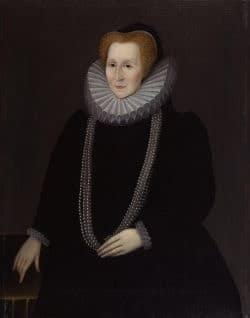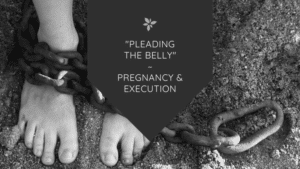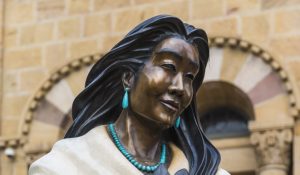Elizabeth Hardwick, better known as Bess of Hardwick, was the daughter of John Hardwick (b. 1495 – d. 29 Jan 1528) and Elizabeth Leake (b. 1499 – d. 1570). The finer details of her early life remain a bit of a mystery though and there isn’t much for us to delve into there. We do have some limited knowledge about her early years though.
We know who her parents were, where she lived, and that her father died when Bess was young – leaving behind a small wedding dowry for his daughters (he had four daughters and one son). A modest, but comfortable life was Bess’s upbringing, which makes it even more incredible where she ended up in life.
There is nothing in her early life that signals the feats in which she would climb. Becoming one of the wealthiest women in Tudor England and being a close friend to Queen Elizabeth I, she climbed her way to the top with a little effort, as well as having four very rich, but very dead husbands.
Her First Marriage at Just Twelve Years Old
During her tender years (i.e. when she was younger than sixteen), Bess had her first marriage. There aren’t many details about this marriage though, but what we do know is that Bess was only twelve years old when she was first married and her husband Robert (whose last name is either Barley or Barlow – no one knows) wasn’t much older.
No one knows where the marriage even took place. But what we do know is that Robert was chronically ill when the two got married. But people have often romanticized their relationship as Bess being the one who nursed him back to health. But he never recovered, and sadly passed away before reaching a mature age.
Since he was so young though, it took Bess eight years of fighting before she could get the inheritance that was rightly hers. In normal circumstances, she would have received one third of her husband’s money as a widow, but her brother-in-law refused to pay her straight away.
During her time as a penniless widow, she sought favour in Lady Frances Grey, Marchioness of Dorset. The Marchioness happened to be niece to Henry VIII…and mother to the doomed “Nine Days’ Queen” Lady Jane Grey. But it is because of this connection that she was able to enter elite Tudor circles and slowly start to become friends with the Queen.
Her Second Marriage to a Man Twice Her Age
Although we know little about her first marriage, we know plenty about her second. This second marriage was a highly recorded event to William Cavendish. A highly rich man, but one who was also nearly twenty years older than Bess. Having said that, we can assume that it was a loving marriage since they had eight children together.
Out of those eight children, six survived past infancy. Her children with William are not the only proof of their love for one another, they were together for ten years before William left this world. Unfortunately, he didn’t just leave his wife and children, he also left them in extreme debt.
But that’s not all, right before she was widowed to her second husband, her husband was also suspected of embezzling funds from the crown. This is not a situation that anyone would want to be in, but luckily for Bess, her husband died before any serious action could be taken. However, she was still left with his huge debt to sort out.
So, with this huge debt, it leaves everyone questioning how she became one of the wealthiest woman in Tudor England. Obviously, being an indebted widow with six children wouldn’t have exactly made her a perfect match. But with her friendship to Elizabeth I, she managed to marry a third time.
Her Third Marriage to Her Wealthy Husband

In 1559, Bess married Sir William St Loe and soon after he was appointed as royal Captain of the Guard by Bess’s close friend Elizabeth I. This marriage was off to a flying start thanks to Bess’s close relationship with the Queen. Not only did Elizabeth I help appoint her husband as the royal Captain of the Guard, she also reduced Bess’s debt.
Elizabeth I of England reduced the huge amount that Hardwick owed to the Crown, and then her third husband was happy to pay off the rest of her debt for her. This was obviously a key moment to helping Bess become the one of the wealthiest women in Tudor England, without this help she might not have got so high up the ladder.
Her husband owned huge amounts of land in the South-West of England and when he died, he left her as one of the wealthiest widows in England. He bequeathed her £60,000, which is about £18,000,000 (possible more) in today’s money! Despite this being the end to her third marriage though, Bess was only in her 30s, and was a huge catch still.
Her Fourth Wedding Was the Lucky Charm
Bess had a great skill at levelling up in the marriage game. When it came to her fourth (and final) marriage, this was an attractive match with George Talbot, 6th Earl of Shrewsbury. He was one of the most prominent men in the English aristocracy and luckily for Bess was also around the same age as her (a match made in heaven you might say).
Despite Bess’s fourth husband being incredibly wealthy, Bess didn’t let this intimidate her. In fact, before getting married, she made her soon to be husband guarantee that her family estate in Chatsworth (and most of her land) would remain under her control, and not go to her husband as would be norm for so many Elizabethan women.
Their marriage wasn’t just focused on the money they each had, they did also appear to be madly in love (at first). We know this from the letters that they sent each other, in which they expressed how they missed their nights together. Her husband even called her “None” – which is an old-timey contraction for “my own”.
But their marriage soon turned sour. By the 1580s, the Shrewsburys’ marital estrangement was a national scandal. It culminated with Shrewsbury accusing Hardwick of stealing from him. So, the question that everyone must be thinking of now, is where did this estrangement and scandal come from?
The Price of Friendship

In 1568, there was a strain put on Hardwick’s fourth marriage, although according to Queen Elizabeth this “strain” was actually an honour. This honour was to be custodians to the exiled Scottish queen/captive Mary, Queen of Scots. Housing a Queen, even a disgrace one, was expensive, and this put a drain on the couple’s finances/good will.
Mary, Queen of Scots was detained in Hardwick’s custody for 15 years (she was executed two years after she left their custody though). But the real issue, the reason why tensions began to arise, was because Bess did the unthinkable during that time, and managed to push Queen Elizabeth’s goodwill too far in 1574.
She was caught conspiring with Mary, Queen of Scots’ mother-in-law, Lady Lennox, to wed Bess’s daughter to Lord Charles Stuart. This was basically treason, a big no-no. Marrying oneself to a candidate for the English and Scottish throne, as well as the Queen’s frenemies, was just something that you should not do.
So, of course, the Queen was furious, but in time she forgave Bess. She even allowed Bess’s daughter to marry Charles Stuart, resulting in the birth of Lady Arbella Stuart. But although the Queen got over it, it enraged Bess’s fourth husband. The Queen did try to help patch the couple back up together, but the love the two had just didn’t return.
The Richest Widow at 63 Years Old
Bess and her husband were unable to have a loving time together towards the end of their relationship, they even spent most of their time in separate residences (having money definitely helped with this). So, it would seem that Bess wasn’t too heartbroken when she became a widow for the fourth and final time.
Instead of wasting her time on another marriage, she took all her wealth and invested it in building one of her largest building projects – Hardwick Hall near her childhood home. A home that has been described as “Hardwick Hall, more window than wall” since the home was revolutionary for its windows.
It was a home that was built to entertain royalty. Certainly, Bess made sure to use all her resources (gained through every marriage), to ensure that she would leave a legacy after her death. She invested everything wisely, leaving behind homes that even now we can still marvel at.
We may not know a lot about her early life, but it is clear that Bess made herself the second wealthiest woman before her death, coming in only after the Queen. She worked hard for that title, earning it through her own dedication and fighting for her own rights. By maintaining her finances properly, she invested her money wisely.
She became a woman who is admired still even today, perhaps unknown to some, she was a fierce woman who has left a legacy that many would struggle to achieve. She is a woman who should not be forgotten and instead should be applauded for her hard work and dedication to becoming an incredibly powerful and extremely rich woman.
Isobel blogs over at castlesandturret.com detailing historical houses, castles, and general day trips. Isobel also loves books and films; give her a historical romance and it would be a perfect afternoon. When it comes to her days off work, you can find Isobel outside and exploring as many places as she can with her partner!






Wow! How disappointing that someone like her is not more well-known!
I enjoy hearing true stories of strong women who are able to outsmart the prevailing boys club mentality and strike out on their own terms. Thank you.
It’s crazy and normal too think/know the history would repeat itself.
Bess and lara
Beautifully written, educational, and inspiring!